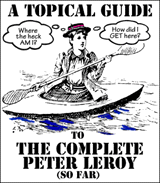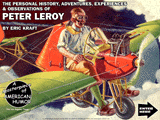
by Mark Dorset
The Minutiae of Everyday Life
The unnamed narrator in Vladimir Nabokov’s “A Guide to Berlin”:
I think that here lies the sense of literary creation: to portray ordinary objects as they will be reflected in the kindly mirrors of future times; to find in the objects around us the fragrant tenderness that only posterity will discern and appreciate in the far-off times when every trifle of our plain everyday life will become exquisite and festive in its own right: the times when the man who might put on the most ordinary jacket of today will be dressed up for an elegant masquerade.
Longinus or Dionysius:
If we look at life from all sides, observing how in everything that concerns us the extraordinary, the great, and the beautiful play the leading part, we shall soon realize the purpose of our creation. This is why, by some sort of natural instinct, we admire, not, surely, the small streams, beautifully clear though they may be, and useful too, but the Nile, the Danube, the Rhine . . . . In all such circumstances, I would say only this, that men hold cheap what is useful and necessary, and always reserve their admiration for what is out of the ordinary.
On the Sublime
(translated by T. S. Dorsch)
Anatole Broyard:
“The familiar man makes the hero artificial,” Wallace Stevens said. In the commonplaceness of their narratives, some of these talkers anticipated the direction that American fiction would eventually take—away from the heroic, the larger than life, toward the ordinary, the smaller than life.
Kafka Was the Rage
Not one novelist in a thousand ever does tell us the real story of their hero. . . . It is the petty details, not in the great results, that the interest of existence lies.
“On Getting on in the World”
in Idle Thoughts of an Idle Fellow
Michel Foucault:
A History of Detail in the eighteenth century, presided over by Jean-Baptiste de La Salle, touching on Leibniz and Buffon, via Frederick II, . . . should bring us, at the end of the century, to the man who dreamt of being another Newton, not the Newton of the immensities of the heavens and the planetary masses, but a Newton of “small bodies,” small movements, small actions; . . . the man who replied to Monge’s remark, “there was only one world to discover”:
“What do I hear? But the world of details, who has never dreamt of that other world, what of that world? I have believed in it ever since I was fifteen. I was concerned with it then, and this memory lives within me, as an obsession never to be abandoned. . . . That other world is the most important of all that I flatter myself I have discovered: when I think of it, my heart aches.”(these words are attributed to Bonaparte in the introduction to Saint-Hilaire’s Notions synthétiques et historiques de philosophie naturelle).
“Docile Bodies” in Practices and Knowledge
Ernst Bloch:
Towards evening is the best time for telling stories. The insignificant world near at hand disappears, distant things which seem better and nearer move up around us. Once upon a time: in fairytale that does not only mean something past, but a more colourful or lighter Elsewhere. And those who live happily ever after there, if they are not dead yet, are still alive to this day. Even in the fairytale there is suffering, but it changes, and does so for good. Gentle, badly treated Cinderella goes to the little tree where her mother's grave lies, little tree wake yourself and shake yourself, a dress falls down, the most splendid and dazzling Cinderella has ever seen, and the slippers are all golden. The fairytale always turns golden in the end, there is enough happiness to go round. It is always the little heroes and the poor folk here who manage to reach the place where life has come good.
The Principle of Hope, Volume 1
See:
Intro to CPL(sf): filling my life with things that I must do, or am obliged to do, or have been made to believe that I ought to do
MMS(aD): I sipped life from the top of the bowl, and I tried to ignore the dark gritty bits at the bottom
See also:
H&L 45 the principles that underlie the life they make for themselves
H&L 557 "Some of them seem to have the expectation - the hope, I should say - that they will turn a corner one day and find that everything is new, all is changed, yet others seem to hope for just the opposite, that things to come will somehow be just as they've been before, that life will stop in a way, freeze, like a snapshot."
RR 93 The entire dream episode has made him very happy. It has made him feel that he is potentially a party to a more exotic life than the one he's currently leading.
RR 194 Sometimes, when a bit of undigested mutton awakens us at night, we lie in the dark, musing. You know the sort of thing. What is the point of life?
LF 121 "Remember this scene," he said. "Here we see Peter's life, in miniature: this pursuing now one notion (or kitten), now another, this inability to concentrate entirely on one thing (or kitten) for fear that the others will get away, though really he might just as well pursue any one of them as all of them, for the kittens, as you and I can see at a glance, are so like one another as to be indistinguishable, each just a variation on the theme 'Black Kitten.' "
LF 240 It has often seemed to us that life, in several respects at any rate, is much like a river. LF 321 Life is like the whole water cycle.
WDYS 54 the entry hall had been laid with terrazzo, the flooring material most like life. To make a terrazzo floor, chips of marble are scattered in a soup of cement, like notable moments scattered through a life
WDYS 296 There will always be some uncertainty. That's life.
(Topical Guide to CPL(sf), pp. 76-79)
E-mail it to me, Mark Dorset.

 Here
are a couple of swell ideas from Eric Kraft's vivacious publicist, Candi
Lee Manning:
Here
are a couple of swell ideas from Eric Kraft's vivacious publicist, Candi
Lee Manning:
